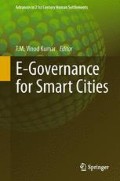Abstract
Issues for developing Smart City E-Governance in India are unique. Two basic issues are the levels of E-Governance Infrastructure in position, namely information and communication technology (ICT) and relative ability of population subgroups to access the E-Governance infrastructure. There has not been uniform social development of urban and rural population and also population subgroups such as male and female, scheduled caste (SC), scheduled tribes (ST), Muslims and non-Muslims in India. Therefore uniform environment of developing Smart City E-Governance does not exist. These target groups require differing policy set to make their access to Smart E-Governance possible. This partitioning of subgroups into different levels of accessibility to Smart E-Governance is the major issues of Smart E-Governance in India. There has been rapid development in ICT such as telephones, mobiles and Internet in India in absolute terms but when it is converted to percentage figures it gives very negative impression doubting the possibility of Smart City E-Governance in India. Also, E-Government survey conducted by United Nations in 2012 places India in the lowest quartile. However recent development of E-Commerce in India gives considerable hopes for E-Governance. E-Commerce and E-Governance shares the same ecosystem but E-Commerce has shown very rapid development and GDP generated can even surpass health and education sector in India. These developments are mainly generated by potential smart cities in India. This gives positive assurance that carefully selected about 31 mega cities, million pilus cities in India and can be developed for Smart City E-Governance. Other towns from about 8,000 census towns have to wait to overcome their population-related access to Smart City E-Governance. This concluding chapter in the last part highlights the further reaches of E-Governance discussed in all chapters of the book as part of its future.
Access this chapter
Tax calculation will be finalised at checkout
Purchases are for personal use only
References
Human Development Report 2010, UNDP National Council of Applied Economic Research, Planning Commission Government of India 2012, India Human Development Report 2011 Towards Social Inclusion
FICCI, Ernst & Young (2009) Making the Indian higher education system future ready. New Delhi
Ministry of Human Resources Development GOI and Confederation of Indian Industry (2013) ASHE-2013 Annual status of higher education of states and UTs. Deloittee Nov 2013
FICCI, Ernst & Young, Planning Commission (2012) Higher education in India twelfth five year plan (2012–2017) and beyond. New Delhi
Planning Commission and Confederation of Indian Industry (2012) ASHE 2012 annual status of higher education of States and UTs in India 2012 (Summary report). New Delhi
Government of India and Confederation of Indian Industries (2013) ASHE 2013 annual status of higher education of States and UTs in India. Deloittee Nov 2013
Telecom Regulatory Authority of India (2013) The Indian telecom service performance indicators Jan–Mar 2013. Mahangar Doorsanchar Bhavan, New Delhi
Earnst & Young (2012) Rebirth of e-commerce in India. New Delhi
McKinsey & Company (2013) Online and upcoming: the internet’s impact on India. New Delhi
India Brand Equity Foundation (2012) The rise and rise of e-commerce in India, New Delhi quoted from World Bank, IAMA and ARNACA Research
World Bank (2011) World development Indicators World Bank UNESCO Global Education Digest 2011
United Nations Department of Social and Economic Affairs (2012) E-Government survey 2012. E-Government for the People, New York
Internet World Statistics (2013) KPMG and internet and mobile association of India report
Author information
Authors and Affiliations
Corresponding author
Editor information
Editors and Affiliations
Rights and permissions
Copyright information
© 2015 Springer Science+Business Media Singapore
About this chapter
Cite this chapter
Vinod Kumar, T.M. (2015). Smart City E-Governance: Issues and Future. In: Vinod Kumar, T. (eds) E-Governance for Smart Cities. Advances in 21st Century Human Settlements. Springer, Singapore. https://doi.org/10.1007/978-981-287-287-6_11
Download citation
DOI: https://doi.org/10.1007/978-981-287-287-6_11
Published:
Publisher Name: Springer, Singapore
Print ISBN: 978-981-287-286-9
Online ISBN: 978-981-287-287-6
eBook Packages: Earth and Environmental ScienceEarth and Environmental Science (R0)

